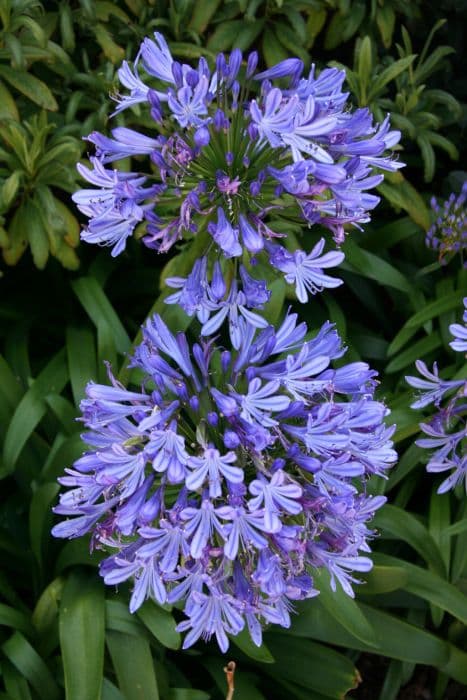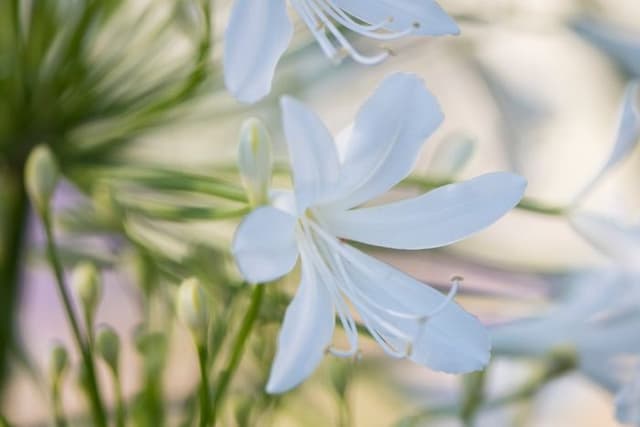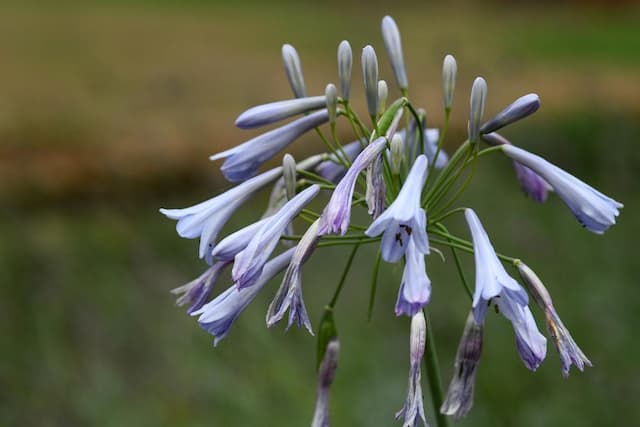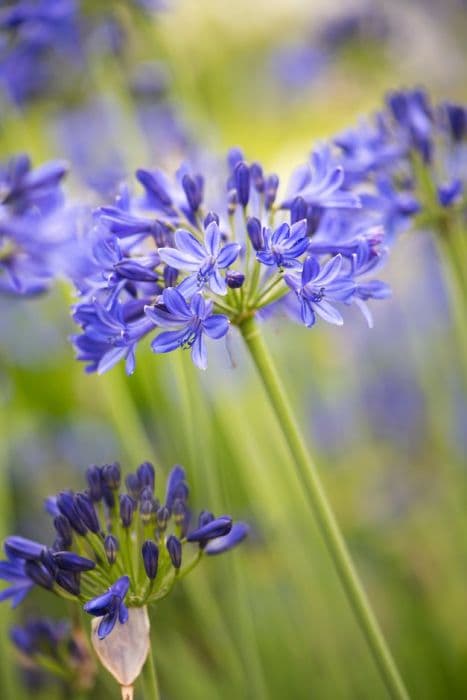Lily of the Nile Agapanthus 'Bray Valley'

ABOUT
Agapanthus 'Bray Valley', commonly known as Lily of the Nile or African Lily, is a striking perennial plant with a lush, attractive appearance. Its most distinctive feature is the large, spherical clusters of flowers, each cluster composed of many trumpet-shaped blooms that sit atop long, sturdy stems. These flowers typically come in shades of blue or purple, giving off a vibrant and captivating look when in full bloom. The foliage of the Lily of the Nile forms a dense clump of strap-shaped leaves that are glossy and rich green in color, contributing to the plant's overall lushness. The leaves arch gracefully from the base and create an elegant backdrop for the tall flowering stalks that rise above them. The contrast between the verdant foliage and the cool-hued blooms makes Agapanthus 'Bray Valley' an eye-catching addition to any garden. During the blooming season, the plant becomes a focal point in the landscape, often attracting butterflies, bees, and other pollinators. Its flower heads can also be used in floral arrangements, adding a touch of drama and height to bouquets. Overall, Agapanthus 'Bray Valley' exudes a tropical aura despite being suited to several climates and brings a sense of sophistication and beauty wherever it is planted.
About this plant
 Names
NamesFamily
Amaryllidaceae
Synonyms
African Lily, Lily of the Nile, Love Flower
Common names
Agapanthus praecox, Agapanthus orientalis.
 Toxicity
ToxicityTo humans
The African Lily, including the 'Bray Valley' cultivar, is known to be mildly toxic to humans if ingested. The plant contains substances that can cause gastrointestinal discomfort such as nausea, vomiting, and diarrhea. In some cases, eating large quantities may result in more severe symptoms. However, poisoning from the African Lily is typically not severe, and serious complications are rare. It is still advisable to keep this plant out of reach of children who might accidentally ingest parts of it.
To pets
The African Lily, including the 'Bray Valley' cultivar, is toxic to pets, including cats and dogs. Ingestion of any part of the plant can lead to symptoms such as nausea, vomiting, and diarrhea. In some cases, more severe symptoms including drooling, lethargy, and abdominal pain may occur. It is recommended to prevent pets from accessing this plant due to its potential toxicity. If a pet does ingest the African Lily, it is advisable to contact a veterinarian.
 Characteristics
CharacteristicsLife cycle
Perennials
Foliage type
Evergreen
Color of leaves
Green
Flower color
Blue
Height
2-3 feet (60-90 cm)
Spread
2-3 feet (60-90 cm)
Plant type
Bulb
Hardiness zones
8
Native area
South Africa
Benefits
 General Benefits
General Benefits- Ornamental appeal: The Agapanthus 'Bray Valley', commonly known as Lily of the Nile, features striking blue flowers that add aesthetic value to gardens and landscapes.
- Low maintenance: This plant is known for being relatively easy to care for, requiring minimal attention once established.
- Drought tolerance: Lily of the Nile is often drought-resistant, making it suitable for xeriscaping and water-wise gardens.
- Long blooming season: It typically has a long flowering period during the summer months, providing colorful blooms over an extended time.
- Attracts pollinators: The flowers of the Lily of the Nile attract bees, butterflies, and other pollinators, supporting local ecosystems.
- Border and container suitability: It is versatile and can be used in garden borders or as a container plant, offering flexibility in garden design.
- Deer resistance: Lily of the Nile is generally resistant to deer, making it a good choice for gardens in areas with deer populations.
 Medical Properties
Medical PropertiesThis plant is not used for medical purposes.
 Air-purifying Qualities
Air-purifying QualitiesThis plant is not specifically known for air purifying qualities.
 Other Uses
Other Uses- Craft projects: The tall and sturdy flower stalks of the Lily of the Nile can be dried and used in floral arrangements or for making wreaths and other craft decorations.
- Dye production: The blue or purple flowers could potentially be used to create natural dyes for fabrics or art projects.
- Fishing aids: In some cultures, plant materials like the fibrous leaves of the Lily of the Nile might be used to make simple fishing nets or lines.
- Photography: The striking blooms of this plant provide an excellent subject for photographers, especially when aiming to capture the intricacies of garden wildlife and plant structures.
- Culinary decoration: Although the plant is not edible, the flowers could be used to garnish dishes for special occasions, with care taken to ensure they don't come into contact with the food.
- Symbolic gifts: As the Lily of the Nile has associations with love and fertility in some cultures, it could be given as a gift during weddings or anniversaries as a symbolic gesture.
- Educational material: Botany students and educators may use Agapanthus plants to study or demonstrate various botanical concepts and plant structures.
- Water-wise landscaping: Due to its drought resistance, the plant is ideal for xeriscaping or low-water gardens, serving as an example of sustainable gardening practices.
- Garden border plants: Their mounding habit and lush foliage make them excellent for improving the edges of garden beds or paths.
- Soil erosion control: Their root systems can help stabilize the soil on slopes, which reduces erosion in vulnerable landscaping areas.
Interesting Facts
 Feng Shui
Feng ShuiThe Lily of the Nile is not used in Feng Shui practice.
 Zodiac Sign Compitability
Zodiac Sign CompitabilityThe Lily of the Nile is not used in astrology practice.
 Plant Symbolism
Plant Symbolism- Love Letters: The name Agapanthus comes from the Greek words 'agape' meaning love, and 'anthos' meaning flower, thereby symbolizing love letters or messages.
- Beauty: Agapanthus, commonly known as the African Lily, is widely appreciated for its beautiful clusters of blue, violet, or white flowers, representing beauty and elegance in the language of flowers.
- Enduring Love: The African Lily is often used in wedding bouquets and floral arrangements to represent everlasting love, due in part to its robust nature and the long-lasting blooms.
 Water
WaterThe African Lily, commonly known as the Agapanthus 'Bray Valley', should be watered deeply to ensure the soil is moist, particularly during its growing season in spring and summer. A general guideline is to water once a week with about 1 to 1.5 gallons, depending on the weather conditions. During hotter spells, it may require more frequent watering. It is important to let the soil dry out slightly between waterings to prevent root rot. During winter, reduce watering to every few weeks or when the soil is dry to the touch, as the plant is dormant and needs less moisture.
 Light
LightAfrican Lilies should be planted in a location that receives full sun to partial shade. They thrive best when they receive at least six hours of direct sunlight daily. However, in very hot climates, they benefit from light afternoon shade to protect them from the intense heat.
 Temperature
TemperatureThe African Lily prefers temperate climates and does well in temperatures between 50 and 80 degrees Fahrenheit. They can survive brief dips down to 40 degrees Fahrenheit but are not frost-tolerant and should be protected when temperatures approach freezing. The ideal temperature range for promoting flowering is between 55 and 75 degrees Fahrenheit.
 Pruning
PruningPrune the African Lily after it has finished flowering, usually in the late summer or fall, to remove spent flower stalks and encourage neatness. Cut the stalks down to the base of the plant. Dividing the clumps every 3 to 4 years in early spring or late summer also encourages vigorous growth and can be considered a form of pruning to maintain plant health.
 Cleaning
CleaningAs needed
 Soil
SoilAfrican Lily thrives in a soil mix with good drainage. Use a combination of loam, compost, and sand or perlite. Aim for a pH range of 6 to 7. Regular feeding with a balanced fertilizer is beneficial during the growing season.
 Repotting
RepottingAfrican Lily should be repotted every 2 to 3 years or when it becomes root-bound. Choose a slightly larger pot to give room for growth.
 Humidity & Misting
Humidity & MistingAfrican Lily prefers moderate humidity levels, but it is quite adaptable. Aim for a humidity range between 40-60% for optimal growth.
 Suitable locations
Suitable locationsIndoor
Bright indirect light, well-drained soil, water when topsoil dries.
Outdoor
Full sun to partial shade, well-drained soil, frost-free area.
Hardiness zone
8-10 USDA
 Life cycle
Life cycleAgapanthus 'Bray Valley', commonly known as the African Lily, begins its life cycle as a seed, which, when sown in a well-drained soil mix, will germinate given the right conditions of warmth and moisture. Upon sprouting, the seedling develops a root system and foliage, gradually forming a clump of strap-like leaves. As the plant matures, it enters a vegetative stage where it focuses on leaf and root development to gather resources for blooming. The reproductive stage is marked by the emergence of tall flower stalks topped with a cluster of blue or purple flowers in the summer months. Once pollination occurs, seeds are produced and the plant begins to enter a period of dormancy, especially in cooler climates, during which the above-ground foliage dies back. The life cycle can then restart from the seeds or vegetatively from the division of the plant's rhizomes or offsets.
 Propogation
PropogationPropogation time
Spring-Early Summer
The Agapanthus 'Bray Valley', commonly known as the African Lily, is typically propagated during late winter or early spring before new growth begins. The most popular method for propagating African Lilies is by division, which involves separating the plant's clump-forming root system. As the plant matures and becomes crowded, it can be lifted from the ground, and the clumps of bulbous roots can be gently teased apart into smaller sections. Each section should have at least one or two healthy shoots. These divided sections are then replanted in well-draining soil, spaced about 18 inches (approximately 45 centimeters) apart to allow sufficient room for growth. After planting, water the newly established plants thoroughly to help establish them in their new location.









